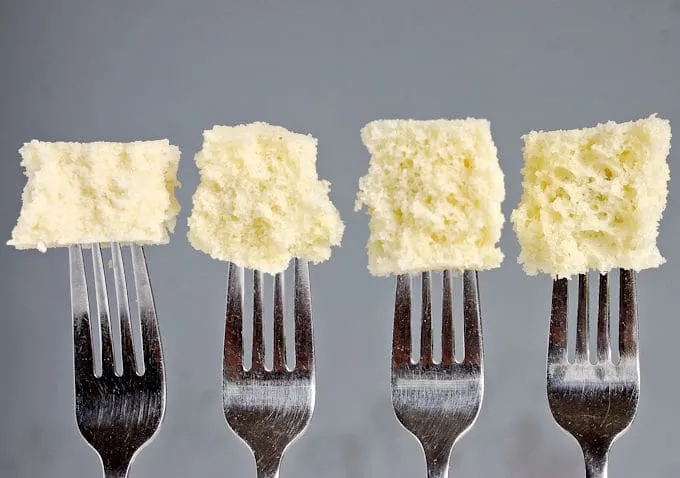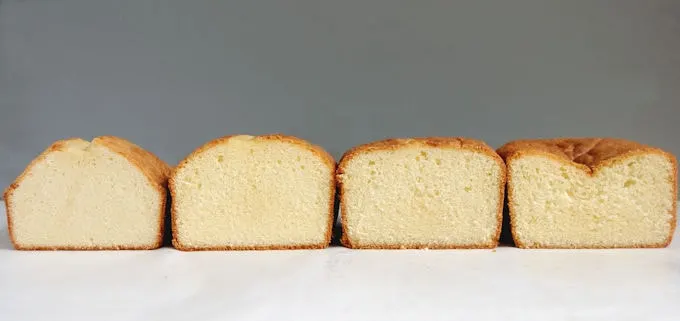Salt & Chemical Leavening: The finishing Touches of Cake Science
Small ingredients that make a big difference.
Salt and leavening agents may not take up much room in a cake recipe, but they have an outsized influence on how a cake bakes.
Salt sharpens flavor and reinforces the batter’s structure, while baking powder and baking soda control how the cake rises and sets.
Understanding how these ingredients behave — and how they interact with one another — is key to baking cakes that are evenly risen, tender, and full-flavored.

Table of contents
⚖️ Salt: Flavor and Structure in Balance
Salt’s role in cake batter is often underestimated. Beyond enhancing sweetness, it strengthens the gluten network that gives cakes a fine, even crumb.
- Flavor Enhancement: A small amount of salt balances sugar and intensifies other flavors, especially vanilla or chocolate.
- Structural Support: Salt slightly tightens gluten bonds, which helps the cake maintain height after leavening gases expand.
- Control: Too much salt will mute sweetness and toughen the texture; too little and the flavor will taste flat.
A typical ratio is 1–2% salt by flour weight (roughly ¼ to ½ teaspoon per cup of flour), but small variations can noticeably change the taste and feel of the crumb.
To understand more about the chemistry of salt see Salt in Baking.
🎈 Chemical Leavening: Creating Lift
Chemical leaveners — baking powder and baking soda — are responsible for the cake’s rise.
- Baking Soda (sodium bicarbonate) needs an acidic ingredient (such as buttermilk, sour cream, or brown sugar) to create carbon dioxide.
- Baking Powder contains both acid and base, so it produces gas when it contacts liquid and again during baking.
When used correctly, they create tiny air pockets that expand in the oven, giving cakes their light, even texture.
To understand more about the chemistry of chemical leavening see Chemical Leaveners in Baking.
How Leavening Is Mixed Affects Cake Texture
It may be hard to believe, but how you add leavening to the batter can have a major impact on the texture of your cake’s crumb.
When baking powder isn’t thoroughly and evenly distributed through the dry ingredients, the cake bakes with tunnels, holes, and rough texture, sometimes even leaving an unpleasant bite of raw baking powder.
To test the best way to mix leavening, I baked three cakes using the same recipe and 1 teaspoon of baking powder, mixed in three different ways:
- Sifted and pre-mixed: Baking powder sifted with the flour, then the dry ingredients mixed on low speed for 20–30 seconds before adding butter.
- Sifted only: Baking powder sifted but not pre-mixed before adding butter.
- Not sifted or mixed: Baking powder added directly to the flour without sifting or pre-mixing.
The difference was clear even before tasting. The first cake had a fine, even crumb. The second had small holes. The third showed tunnels and rough texture throughout.
Baking Sense Tip
Always sift and mix baking powder thoroughly with the flour before adding fat or liquid. Those few extra seconds of mixing prevent tunnels and give your cake a fine, even crumb.
🧠 Balancing Salt and Leavening Together
Salt and leaveners influence each other’s effects. Salt slows yeast fermentation in breads, but in cakes, it helps control the speed of the chemical reactions, preventing an overly rapid rise that might collapse before the structure sets. The trick is balance: enough leavening to lift, enough salt to stabilize and flavor.
If your cakes tend to dome sharply or collapse in the center, it’s often a sign that your leavening is slightly too strong for your batter’s structure. Reducing the baking powder by even ¼ teaspoon can restore balance.

🧩 Takeaway
Salt and chemical leavening agents are quiet players, but they determine whether a cake is bland or flavorful, dense or airy. Once you understand how they work together, you can fine-tune your recipes for flavor, lift, and structure, creating cakes that rise beautifully and taste even better.
📚 Continue Learning
This lesson is part of my Cake Recipe Science series, where I explain how each ingredient and mixing method shapes a cake’s structure, texture, and flavor. Explore the full series to learn how flour, sugar, eggs, fats, and leavening work together to create the perfect cake crumb.
← Previous: Sugar in Cake Recipes | Next: Mixing Methods→
